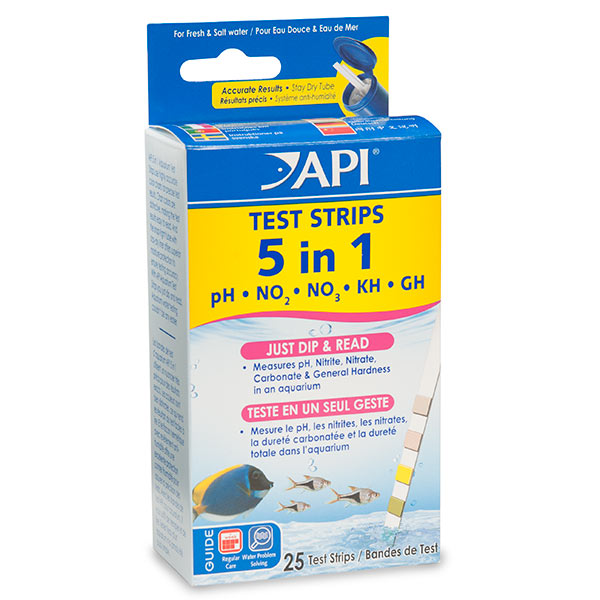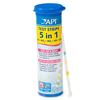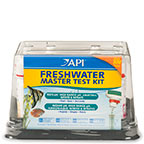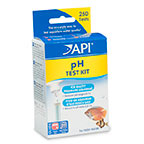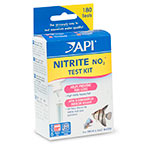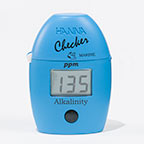Additional sizes may be available!
Additional sizes may be available! Email me when availableOverview
| * | Convenient easy-to-use test strips for fresh or saltwater aquariums |
| * | Test for aquarium pH, nitrite, nitrate, carbonate & general hardness |
| * | Precise color chart & snap tight tube ensure accurate test results |
Simplify routine testing to ensure best care of aquarium inhabitants. API 5 in 1 Aquarium Test Strips for fresh and saltwater aquariums provide hobbyists a quick and easy way to test five of the most important measures of aquarium water quality. A single test strip measures aquarium General Hardness (GH), Carbonate Hardness (KH), pH, Nitrite (NO2) and Nitrate (NO3) all at once.
API 5 in 1 Aquarium Test Strips help ensure more accurate results with highly precise color charts that ease color matching. Stay-dry tube with snap tight cap offers maximum protection against moisture that can compromise test strip accuracy. For use with freshwater and saltwater aquariums. 25 count.
Instructions:
- Dip strip directly into aquarium.
- SWIRL 2 TIMES.
- Remove horizontally with pads facing up.
- DO NOT SHAKE OFF EXCESS WATER.
- Compare to the color chart on the tube.
- Starting with the pad closest to your hand, immediately read General Hardness (GH) and Carbonate Hardness (KH).
- Wait 30 seconds, and then read pH, Nitrite (NO2) and Nitrate (NO3).
- Keep wet fingers out of the tube.
- Close tube tightly after removing strip.
- Store in a cool, dry place.
- For best results, read in well-lit area.
General Information
It is important for aquarists to provide a healthy aquarium by approximating the water conditions of the natural habitats of their fish. This requires routine water testing to make sure conditions are correct for the fish being kept. API 5 in 1 Aquarium Test Strips are the quick and easy way to test 5 of the most important measures of aquarium water quality: General Hardness (GH), Carbonate Hardness (KH), pH, Nitrite (NO2) and Nitrate (NO3). These 5 parameters should be tested weekly, since natural materials in the aquarium, such as fish waste and decaying food as well as water changes and evaporation can cause these levels to shift over time.
General Hardness (GH) Test
What is General Hardness (GH)?
General Hardness is the measure of calcium (Ca2+) and magnesium (Mg2+) ion concentrations dissolved in water. These minerals are present in municipal, well, and bottled spring water. The GH in tap water depends on the source of the water and the treatment processes it has undergone. Hard water (?200 ppm) is high in calcium and magnesium. Soft water (50 to 100 ppm) is low in these minerals.
- This test reads from 0-180 parts per million (ppm) in freshwater (ppm is equivalent to mg/L). To convert ppm to German Degrees (°dGH), divide the reading by 17.9.
- It is important to monitor the GH in both the aquarium and in the tap water. Some tap water supplies have a low GH while others have a high GH.
- Even if the GH is correct initially, it can increase sharply over time. As water evaporates from the aquarium, it leaves the hardness mineral behind. Topping off with tap water simply adds more minerals to the aquarium. This can result in stressful conditions for the fish.
- This test cannot be used in saltwater because the Calcium (Ca2+) and Magnesium (Mg2+) ion concentrations in saltwater as above the range of this test.
What the Test Results Mean
The table below is a guide to the desired General Hardness (GH) for certain common tropical fish and live plants.
| ppm (mg/L) | °dGH | Type of Fish |
| 30 | 1.7° | Discus, arowanas, elephant nose, neons, cardinals, live plants |
| 60 | 3.4° | Most tropical fish including angelfish, tetras, botia, community aquarium fish, live plants |
| 120 | 6.7° | Most tropical fish including swordtails, guppies, mollies, cichlids, goldfish |
| 180 | 10° | African Cichlids, goldfish |
Reducing GH
- GH can be lowered by using an API Water Softener Pillow in the filter. This will remove calcium and magnesium ions through ion exchange.
- Partial water changes using distilled or de-ionized water can also reduce the GH. Use the API Tap Water Filter to remove all minerals from tap water, creating de-ionized water. The API Tap Water Filter turns any tap water into perfect aquarium water.
Increasing GH
African Cichlids require water with a high GH. API Electro Right or African Cichlid Salts can be used to increase the GH.
Carbonate Hardness (KH) Test
What is Carbonate Hardness (KH)?
Carbonate hardness (KH), also known as alkalinity is the measure of carbonate (CO32-) and bicarbonate (HC03-) ion concentrations dissolved in water. Carbonate hardness helps stabilize pH in the aquarium. An aquarium with a low KH level (50-100 ppm) will tend to be acidic. Aquariums with very low KH are subject to rapid pH shifts, if not monitored carefully. This causes stressful conditions for fish. An aquarium with a high KH level (?200 ppm) will tend to have a high pH. Even if the KH is correct initially, it can decrease over time as carbonates are used by the biological filter and plants.
Testing Tips
- This test reads from 0-240 ppm in freshwater (ppm is equivalent to mg/L). To convert ppm to German Degrees (°dGH), divide the reading by 17.9.
- Carbonate and bicarbonate ions are present in municipal, well and bottled spring water. The KH in tap water depends on the source water and the treatment process it has undergone.
What the Test Results Mean
In order to provide the proper environment for your fish and to ensure a stable pH, it is important to monitor the KH in both the aquarium and the tap water. The table below is a guide to the desired KH for certain common tropical fish and live plants.
| ppm (mg/L) | °dGH | Type of Fish |
| 40 | 2.2° | Discus, arowanas, elephant nose, neons, cardinals, live plants |
| 80 | 4.5° | Most tropical fish including angelfish, tetras, botia, community aquarium fish, live plants |
| 120 | 6.7° | Most tropical fish including swordtails, guppies, mollies, cichlids, goldfish |
| 180 | 10° | African Cichlids, goldfish, brackish water & marine fish |
| 240 | 13.4° | African Cichlids, goldfish, brackish water & marine fish |
- KH can be lowered by making partial water changes using distilled or de-ionized water. Use the API Tap Water Filter to remove all minerals from tap water, creating de-ionized water. The API Tap Water Filter turns any tap water into perfect aquarium water.
Increasing KH
KH can be increased by using API Proper pH API Proper pH 6.5, 7.0 and 7.5 are non-carbonate buffers that automatically adjust the pH and stabilize the KH in freshwater.
pH Test
Why Test pH?
In order for your fish to thrive, it is important to maintain the pH in the aquarium at a level similar to their native habitat. A pH reading of 7.0 is neutral, a pH above 7.0 is alkaline and a pH below 7.0 is acidic. The water in the natural habitat of some species is neutral, while that of other species is either acidic or alkaline. Most freshwater fish will thrive at a pH range of 6.8-7.5. The pH of natural ocean water is between 8.2-8.4, therefore, saltwater fish and invertebrates should be kept in that range.
Testing Tips
- The pH should be tested weekly, since natural materials in the aquarium such as fish waste and decaying food can cause changes in the pH over time.
- This test kit measures pH from 6.0-9.0 in freshwater and saltwater. pH below 6.0 will read 6.0 and pH above 9.0 will read 9.0. In these extreme conditions, pH adjustments to the water will not show any change
- Be sure to use the freshwater color chart when testing freshwater and the saltwater chart when testing saltwater.
What the Test Results Mean
Recommended pH Levels
A pH of 6.8-7.2 is ideal when keeping a community aquarium containing a variety of tropical fish. Goldfish should be kept in their own aquarium and prefer a pH of 7.5. Many Amazonian fish like angelfish and neon tetras prefer a pH of 6.5-6.8. Mollies and swordtails thrive at a pH range of 7.2-7.5. Most African Cichlids need an n pH of 8.2 or higher.
To raise or lower pH in a freshwater aquarium, use API pH UP or pH DOWN. API Proper pH 6.5, 7.0 and 7.5 can be used to automatically adjust the pH to the appropriate levels.
Nitrite and Nitrate Test
Why Test Nitrite & Nitrate?
Nitrite (NO2-) and Nitrate (NO3-) are produced in the aquarium by the biological filter. Beneficial bacteria convert toxic ammonia into nitrite (also toxic) and then convert the nitrite into nitrate. An established aquarium should have 0 ppm nitrite but nitrate will continue to increase over time.
Nitrite: Testing for nitrite is essential so that if it is present, steps can be taken to remove it. Nitrite in the aquarium water interferes with fish respiration and high levels of nitrite quickly lead to fish death. Even a trace amount of nitrite causes fish stress, suppressing the immune system. This increases the likelihood of disease and subsequent death.
Nitrate: The biological filter constantly produces nitrate in an aquarium. A high nitrate level indicates a buildup of fish waste and organic compounds, causing poor water quality and contributing to the likelihood of fish disease. Excessive nitrate also provides a nitrogen source that can stimulate algal blooms (green water). Many aquarists believe that maintaining a low level of nitrate improves the health of fish and invertebrates.
Testing Tips
- Nitrite and Nitrate should be tested once a week as a routine part of aquarium maintenance in order to make sure that they do not reach undesirable levels.
- This test kit reads total Nitrite (NO2-) and total Nitrate (NO3-) in ppm.
- Nitrite Test reads from 0 to 10 ppm; Nitrate Test reads from 0 to 200 ppm.
- Be sure to use the correct color chart when reading the results.
What the Test Results Mean
Nitrite:
- In new aquariums, the nitrite level can gradually climb to 5 ppm or more. As the biological filter becomes established (in 4 to 6 weeks), the nitrite levels will drop to 0 ppm.
- In established aquariums, the nitrite level should always be 0 ppm. The presence of nitrite in established aquariums indicates possible over-feeding, too many fish or inadequate biological filtrations.
Nitrate:
- In new aquariums, the nitrate level can gradually climb as the biological filter becomes established.
- A nitrate level of 40-ppm or less is recommended for freshwater aquariums. For saltwater aquariums, many marine aquarists prefer to keep the nitrate level as low as possible, especially when keeping invertebrates.
Reducing Nitrite and Nitrate
In Freshwater
- API Nitra-Zorb will remove both nitrite and nitrate from freshwater aquariums. Nitra-Zorb is a very effective blend of resins in a rechargeable pouch. It will not only remove nitrite and nitrate, but ammonia as well.
- Partial water changes can help to reduce nitrite levels but may not reduce nitrate levels much, because tap water may contain up to 40-ppm nitrate. If your tap water contains nitrate, use the API Tap Water Filter to remove all pollutants including nitrate, from the water in order to make the changes effective. The API Tap Water Filter turns any tap water into perfect aquarium water.
- Use API Stress Zyme to help speed up the development of the biological filter to reduce the level of nitrite.
- Use API Aquarium Salt to reduce the nitrite toxicity to fish while the biological filter is removing the nitrite.
- Use API Stress Zyme to help speed up the development of the biological filter to reduce the level of nitrite.
- Partial water changes help to reduce nitrite levels but may contain up to 40-ppm nitrate. If your tap water contains nitrate, use the API Tap Water Filter to remove all pollutants including nitrate, from the water in order to make the changes effective.
In Saltwater


